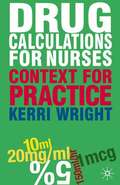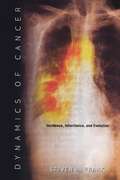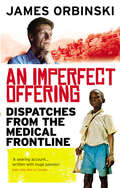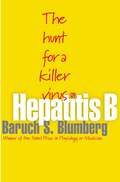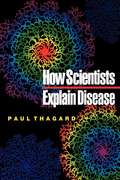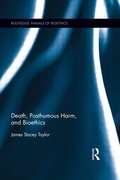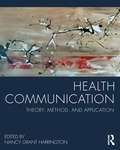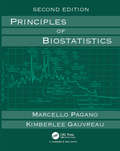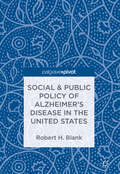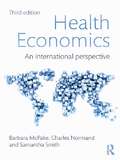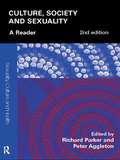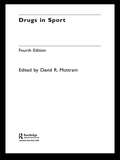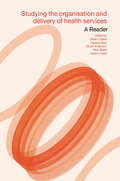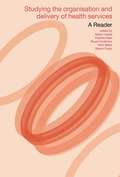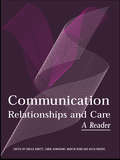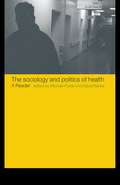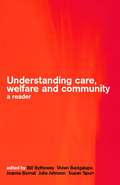- Table View
- List View
Drug Calculations for Nurses: Context for Practice (PDF)
by Kerri WrightThis innovative text uses a 'common sense' approach to introduce students to real-life medication problems. Featuring a range of exercises and assessments and supported by an interactive companion website, this is the perfect handbook for anyone seeking to improve their numeracy skills for medication administration.
Drug Calculations for Nurses: Context for Practice
by Kerri WrightThis innovative text uses a 'common sense' approach to introduce students to real-life medication problems. Featuring a range of exercises and assessments and supported by an interactive companion website, this is the perfect handbook for anyone seeking to improve their numeracy skills for medication administration.
Dynamics of Cancer: Incidence, Inheritance, and Evolution (PDF) (Princeton Series in Evolutionary Biology)
by Steven A. FrankThe onset of cancer presents one of the most fundamental problems in modern biology. In Dynamics of Cancer, Steven Frank produces the first comprehensive analysis of how particular genetic and environmental causes influence the age of onset. The book provides a unique conceptual and historical framework for understanding the causes of cancer and other diseases that increase with age. Using a novel quantitative framework of reliability and multistage breakdown, Frank unifies molecular, demographic, and evolutionary levels of analysis. He interprets a wide variety of observations on the age of cancer onset, the genetic and environmental causes of disease, and the organization of tissues with regard to stem cell biology and somatic mutation. Frank uses new quantitative methods to tackle some of the classic problems in cancer biology and aging: how the rate of increase in the incidence of lung cancer declines after individuals quit smoking, the distinction between the dosage of a chemical carcinogen and the time of exposure, and the role of inherited genetic variation in familial patterns of cancer. This is the only book that presents a full analysis of the age of cancer onset. It is a superb teaching tool and a rich source of ideas for new and experienced researchers. For cancer biologists, population geneticists, evolutionary biologists, and demographers interested in aging, this book provides new insight into disease progression, the inheritance of predisposition to disease, and the evolutionary processes that have shaped organismal design.
An Imperfect Offering: Dispatches From The Medical Frontline
by James OrbinskiBorn in Britain in 1960, James Orbinski's family moved to Canada when he was seven years old. As a young man, he became a medic to learn how to help, and deal with, the suffering of others. From then on he was plunged into many highly demanding situations, including being Head of Mission for Medecins Sans Frontieres (MSF) during the Rwandan genocide; engaging with the politics of humanitarian work as the President of MSF; being in New York when the twin towers of the World Trade Center fell on September 11; co-founding Dignitas International (an AIDS charity); and finally, returning to Rwanda on the 10th anniversary of the crisis there. In An Imperfect Offering, Orbinski not only tells his own inspiring story but is also remarkably provocative about what governments and agencies should and shouldn't be doing to help the world's poor and very sick. At the same time, he addresses what part each of us can play, so that we never lose sight of the dignity of those being helped, or deny them the right to act in their own lives. His conclusion is blunt and profound: 'Humanity is lost or saved one person at a time, one intention at a time, and one action at a time. There are no utopias waiting to be born. There is only what we do - what you choose to do...'
Hepatitis B: The Hunt for a Killer Virus (PDF)
by Baruch S. BlumbergAbout 375 million people are infected with the hepatitis B virus. It has killed more people than AIDS and also causes millions of cases of liver cancer. The discovery of this deadly virus and the vaccine against it--a vaccine that is sharply decreasing the infection rate worldwide and is probably the first effective cancer vaccine--was one of the great triumphs of twentieth-century medicine. And it almost didn't happen. With wit and insight, this scientific memoir and story of discovery describes how Baruch Blumberg and a team of researchers found a virus they were not looking for and created a vaccine for a disease they previously knew little about--work that took the author around the world and won him the Nobel Prize. Blumberg and his collaborators were investigating relationships between gene distribution and disease susceptibility, research that was yielding interesting data but no real breakthroughs. Many viewed their work as more field trip than science. But, through decades of hard work and investigative twists and turns, their pursuit led to the hepatitis B antigen, the elusive virus itself, and, ultimately, the vaccine. As he takes the reader through the detective work that culminated in his incredible discovery, the author recounts with immediacy exciting moments in the lab and in the field--from a hair-raising flight to Africa to an unpleasant encounter with Alaskan sled dogs. The hepatitis B story is more than a fascinating chronicle of a major discovery. What Blumberg followed to the virus was a trail of remarkable "accidents" that happen when scientists seek answers to interesting questions. Those events, combined with the investigator's determined persistence, resulted in studies that generated a pharmaceutical industry, have far-flung public-health applications, and saved millions of lives.
How Scientists Explain Disease (PDF)
by Paul ThagardHow do scientists develop new explanations of disease? How do those explanations become accepted as true? And how does medical diagnosis change when physicians are confronted with new scientific evidence? These are some of the questions that Paul Thagard pursues in this pathbreaking book that develops a new, integrative approach to the study of science. Ranging through the history of medicine, from the Hippocratic theory of humors to modern explanations of Mad Cow Disease and chronic fatigue syndrome, Thagard analyzes the development and acceptance of scientific ideas. At the heart of the book is a case study of the recent dramatic shift in medical understanding of peptic ulcers, most of which are now believed to be caused by infection by the bacterium Helicobacter pylori. When this explanation was first proposed in 1983, it was greeted with intense skepticism by most medical experts, but it became widely accepted over the next decade. Thagard discusses the psychological processes of discovery and acceptance, the physical processes involving instruments and experiments, and the social processes of collaboration, communication, and consensus that brought about this transformation in medical knowledge. How Scientists Explain Disease challenges both traditional philosophy of science, which has viewed science as largely a matter of logic, and contemporary science studies that view science as largely a matter of power. Drawing on theories of distributed computing and artificial intelligence, Paul Thagard develops new models that make sense of scientific change as a complex system of cognitive, social, and physical interactions. This is a book that will appeal to all readers with an interest in the development of science and medicine. It combines an engaging style, significant research, and a powerfully original argument.
Death, Posthumous Harm, And Bioethics
by James Stacey TaylorDeath, Posthumous Harm, and Bioethics offers a highly distinctive and original approach to the metaphysics of death and applies this approach to contemporary debates in bioethics that address end-of-life and post-mortem issues. Taylor defends the controversial Epicurean view that death is not a harm to the person who dies and the neo-Epicurean thesis that persons cannot be affected by events that occur after their deaths, and hence that posthumous harms (and benefits) are impossible. He then extends this argument by asserting that the dead cannot be wronged, finally presenting a defence of revisionary views concerning posthumous organ procurement.
Death, Posthumous Harm, And Bioethics (PDF)
by James Stacey TaylorDeath, Posthumous Harm, and Bioethics offers a highly distinctive and original approach to the metaphysics of death and applies this approach to contemporary debates in bioethics that address end-of-life and post-mortem issues. Taylor defends the controversial Epicurean view that death is not a harm to the person who dies and the neo-Epicurean thesis that persons cannot be affected by events that occur after their deaths, and hence that posthumous harms (and benefits) are impossible. He then extends this argument by asserting that the dead cannot be wronged, finally presenting a defence of revisionary views concerning posthumous organ procurement.
Health Communication: Theory, Method, and Application
by Nancy Grant HarringtonHealth Communication provides coverage of the major areas of interest in the field of health communication, including interpersonal, organizational, and health media. It takes an in-depth approach to health communication research by analyzing and critically evaluating research conducted across multiple paradigmatic perspectives. This edited textbook includes chapters covering such topics as: interpersonal health communication issues, challenges, and complexities in health communication, communication aspects of health behaviors and conditions, organizational issues in health communication, and media and eHealth research. Chapters have been contributed by noted researchers and educators in health communication and represent the current state of the field. They offer pedagogical features that will prove useful to students and instructors of health communication, such as sidebars, summary boxes, suggestions for in-class activities, discussion questions, and lists of additional resources. A companion website provides online resources for use with this text, including: For students: Test questions Downloadable flash cards Exam study guides For instructors: PowerPoint slides Sample syllabi Sample assignments Developed for use in upper-level health communication courses, this text represents the breadth and depth of health communication theory and research as it exists today.
Health Communication: Theory, Method, and Application
by Nancy Grant HarringtonHealth Communication provides coverage of the major areas of interest in the field of health communication, including interpersonal, organizational, and health media. It takes an in-depth approach to health communication research by analyzing and critically evaluating research conducted across multiple paradigmatic perspectives. This edited textbook includes chapters covering such topics as: interpersonal health communication issues, challenges, and complexities in health communication, communication aspects of health behaviors and conditions, organizational issues in health communication, and media and eHealth research. Chapters have been contributed by noted researchers and educators in health communication and represent the current state of the field. They offer pedagogical features that will prove useful to students and instructors of health communication, such as sidebars, summary boxes, suggestions for in-class activities, discussion questions, and lists of additional resources. A companion website provides online resources for use with this text, including: For students: Test questions Downloadable flash cards Exam study guides For instructors: PowerPoint slides Sample syllabi Sample assignments Developed for use in upper-level health communication courses, this text represents the breadth and depth of health communication theory and research as it exists today.
Principles of Biostatistics
by Marcello Pagano Kimberlee GauvreauThis edition is a reprint of the second edition published in 2000 by Brooks/Cole and then Cengage Learning. Principles of Biostatistics is aimed at students in the biological and health sciences who wish to learn modern research methods. It is based on a required course offered at the Harvard School of Public Health. In addition to these graduate students, many health professionals from the Harvard medical area attend as well. The book is divided into three parts. The first five chapters deal with collections of numbers and ways in which to summarize, explore, and explain them. The next two chapters focus on probability and introduce the tools needed for the subsequent investigation of uncertainty. It is only in the eighth chapter and thereafter that the authors distinguish between populations and samples and begin to investigate the inherent variability introduced by sampling, thus progressing to inference. Postponing the slightly more difficult concepts until a solid foundation has been established makes it easier for the reader to comprehend them. The supplements include a manual for students with solutions for odd-numbered exercises, a manual for instructors with solutions to all exercises, and selected data sets. Marcello Pagano is Professor of Statistical Computing in the Department of Biostatistics at the Harvard School of Public Health. His research in biostatistics is on computer intensive inference and surveillance methods that involve screening methodologies, with their associated laboratory tests, and in obtaining more accurate testing results that use existing technologies. Kimberlee Gauvreau is Associate Professor in the Department of Biostatistics and Associate Professor of Pediatrics at Harvard Medical School. Dr. Gauvreau’s research focuses on biostatistical issues arising in the field of pediatric cardiology. She also works on the development and validation of methods of adjustment for case mix complexity.
Social & Public Policy of Alzheimer's Disease in the United States
by Robert H. BlankThis book focuses on the public policy and political dimensions of Alzheimer’s Disease and other dementias (AD/D) in the United States, with coverage of the global dimensions and relevant examples from other countries. Starting off with a discussion on the characteristics of AD/D and competing theories of their causes, their human and financial costs, and the increasing burden they place on all societies as populations age, the book examines in detail the range of policy issues they raise. These include funding policies, payment policy and regulatory functions, long-term services and support (LTCS), public health and prevention policies.The book analyses the big business surrounding AD/D and shows that the strong public fear of developing dementia heightens the likelihood of exploitation of vulnerable people looking for a technological fix. It examines both informal and formal caregivers and the heavy burden placed on families, primarily women, and recent policy attempts to strengthen LTCS. It also examines the latest evidence of potential risk-reduction and prevention strategies and the difficult issues surrounding advance directives, assisted suicide, and definitions of death that increasingly face policy makers. It concludes by analyzing the policy implications on possible technological scenarios.
Social & Public Policy of Alzheimer's Disease in the United States
by Robert H. BlankThis book focuses on the public policy and political dimensions of Alzheimer’s Disease and other dementias (AD/D) in the United States, with coverage of the global dimensions and relevant examples from other countries. Starting off with a discussion on the characteristics of AD/D and competing theories of their causes, their human and financial costs, and the increasing burden they place on all societies as populations age, the book examines in detail the range of policy issues they raise. These include funding policies, payment policy and regulatory functions, long-term services and support (LTCS), public health and prevention policies.The book analyses the big business surrounding AD/D and shows that the strong public fear of developing dementia heightens the likelihood of exploitation of vulnerable people looking for a technological fix. It examines both informal and formal caregivers and the heavy burden placed on families, primarily women, and recent policy attempts to strengthen LTCS. It also examines the latest evidence of potential risk-reduction and prevention strategies and the difficult issues surrounding advance directives, assisted suicide, and definitions of death that increasingly face policy makers. It concludes by analyzing the policy implications on possible technological scenarios.
Health Economics: An International Perspective
by Barbara McPake Charles Normand Samantha Smith Anne NolanThis third edition of Barbara McPake and Charles Normand’s textbook confirms it as providing the only properly international treatment of health economics on the market. A key tenet of the book is its analysis of comparative health systems across borders, and the text has been updated and revised to take account of changes in a host of countries. Barack Obama’s reforms in the United States are considered alongside the provision of healthcare in China, providing a unique overview of these different approaches. The introduction of performance related payment in various forms is appraised, with the experience of developing countries such as Cambodia, Rwanda and Uganda important in this regard. An overview of the range of mathematical techniques available to perform economic evaluation in healthcare is also introduced, although the text avoids becoming too technical. In all, the text builds on the success of the first edition and provides the perfect introduction to the fast changing world of health economics.
Health Economics: An International Perspective
by Barbara McPake Charles Normand Samantha Smith Anne NolanThis third edition of Barbara McPake and Charles Normand’s textbook confirms it as providing the only properly international treatment of health economics on the market. A key tenet of the book is its analysis of comparative health systems across borders, and the text has been updated and revised to take account of changes in a host of countries. Barack Obama’s reforms in the United States are considered alongside the provision of healthcare in China, providing a unique overview of these different approaches. The introduction of performance related payment in various forms is appraised, with the experience of developing countries such as Cambodia, Rwanda and Uganda important in this regard. An overview of the range of mathematical techniques available to perform economic evaluation in healthcare is also introduced, although the text avoids becoming too technical. In all, the text builds on the success of the first edition and provides the perfect introduction to the fast changing world of health economics.
Culture, Society and Sexuality: A Reader (Sexuality, Culture and Health)
by Richard Parker Peter AggletonThis new and revised edition of Culture, Society and Sexuality brings together and makes accessible a broad and international selection of readings to provide insights into the social, cultural, political and economic dimensions of sexuality and relationships, and emerging discourses around sexual and reproductive rights. Clearly structured and presented, the book makes an extremely useful reference for students and researchers. Section one focuses on the social and cultural construction of sexuality as an emerging field of inquiry over the course of recent decades, and examines some of the most important theoretical insights and areas of investigation that have emerged as this field has developed. Section two links research on the construction of sexuality to a growing body of work on gender and sexuality in relation to a wide range of practical issues and contemporary social policy debates. It is an essential reader not only for students and researchers in these areas, but also for activists, health workers and service providers, who daily confront practical and policy issues related to sexuality, sexual health and sexual rights.
Culture, Society and Sexuality: A Reader (Sexuality, Culture and Health)
by Richard Parker Peter AggletonThis new and revised edition of Culture, Society and Sexuality brings together and makes accessible a broad and international selection of readings to provide insights into the social, cultural, political and economic dimensions of sexuality and relationships, and emerging discourses around sexual and reproductive rights. Clearly structured and presented, the book makes an extremely useful reference for students and researchers. Section one focuses on the social and cultural construction of sexuality as an emerging field of inquiry over the course of recent decades, and examines some of the most important theoretical insights and areas of investigation that have emerged as this field has developed. Section two links research on the construction of sexuality to a growing body of work on gender and sexuality in relation to a wide range of practical issues and contemporary social policy debates. It is an essential reader not only for students and researchers in these areas, but also for activists, health workers and service providers, who daily confront practical and policy issues related to sexuality, sexual health and sexual rights.
Drugs in Sport
by David R. MottramWith the recent major updates in worldwide anti-doping laws and changes to the prohibited and therapeutic exemption lists, this fourth edition of the bestselling Drugs in Sport presents authoritative, hard science information about the actions of drugs, hormones, medication and nutritional supplements in sport. Written by a well respected pharmacologist from one of the UK’s leading sports science universities, this much-needed new edition of a market leader continues to focus on one of the most high profile themes in sport science, providing high quality detailed information. Some of the key issues covered include: * the latest doping control regulations of the WADA* the use of therapeutic drugs banned in sport* an assessment of the prevalence of drug taking in sport.
Studying the Organisation and Delivery of Health Services: A Reader (Social Aspects Of Aids Ser.)
by Pauline Allen Nick Black Aileen Clarke Naomi Fulop Stuart AndersonResearch into the delivery and organisation of health care is a vital component in the improvement of health services. A wide range of disciplines and methods needs to be deployed to address research questions in this field. This unique reader brings together thirty examples of high-quality SDO research using a range of disciplines, including organisational studies, epidemiology, sociology, history, health economics, anthropology and policy studies, illustrating the use of qualitative and quantitative approaches and primary and secondary research. Expert editorial commentary on each section highlights different themes and methodological issues. The reader covers six main areas of research: Organising services around the user User involvement in organising services Workforce issues Evaluating models of service delivery Quality management and the management of change Studying health care organisations. This book is a companion volume to Studying the Organisation and Delivery of Health Services: Research Methods also published by Routledge (2001). It makes top-quality, empirical and secondary research readily accessible to health service managers and health care professionals who are interested in research, to health service researchers and to undergraduate and postgraduate students following courses in health and health management studies.
Studying the Organisation and Delivery of Health Services: A Reader
by Pauline Allen Nick Black Aileen Clarke Naomi Fulop Stuart AndersonResearch into the delivery and organisation of health care is a vital component in the improvement of health services. A wide range of disciplines and methods needs to be deployed to address research questions in this field. This unique reader brings together thirty examples of high-quality SDO research using a range of disciplines, including organisational studies, epidemiology, sociology, history, health economics, anthropology and policy studies, illustrating the use of qualitative and quantitative approaches and primary and secondary research. Expert editorial commentary on each section highlights different themes and methodological issues. The reader covers six main areas of research: Organising services around the user User involvement in organising services Workforce issues Evaluating models of service delivery Quality management and the management of change Studying health care organisations. This book is a companion volume to Studying the Organisation and Delivery of Health Services: Research Methods also published by Routledge (2001). It makes top-quality, empirical and secondary research readily accessible to health service managers and health care professionals who are interested in research, to health service researchers and to undergraduate and postgraduate students following courses in health and health management studies.
Communication, Relationships and Care: A Reader
by Sheila Barrett Carol Komaromy Martin Robb Anita RogersCommunication and relationships have become an increasing focus of attention in debates about the future of health and social care. People working in care services are being encouraged to improve communication processes, to develop more participatory relationships with service users, and to work more closely in partnership with other professionals. This Reader provides a comprehensive collection of literature that aims to enable those involved in care services, as workers, carers or service users, to reflect on their everyday interactions and to situate them in wider contexts. Including new material from the frontline of research and practice, as well as some classic readings, this wide-ranging volume emphasises the need to see interpersonal communication as embedded in relationships, and to take account of issues of power and diversity, as well as the emotional dimension of care work. Covering both health and social care, the Reader is divided into four sections, focusing on:* concepts and contexts* analysing aspects of communication* the person in the process* communication and relationships in organisations.Communication, Relationships and Care will be an essential resource for students of social work, nursing, health and social policy, and for all involved in health and social care services, whether as professionals, carers or service users. It is a set book for the Open University's second level undergraduate course Communication and Relationships in Health and Social Care (K205).
Communication, Relationships and Care: A Reader
by Sheila Barrett Carol Komaromy Martin Robb Anita RogersCommunication and relationships have become an increasing focus of attention in debates about the future of health and social care. People working in care services are being encouraged to improve communication processes, to develop more participatory relationships with service users, and to work more closely in partnership with other professionals. This Reader provides a comprehensive collection of literature that aims to enable those involved in care services, as workers, carers or service users, to reflect on their everyday interactions and to situate them in wider contexts. Including new material from the frontline of research and practice, as well as some classic readings, this wide-ranging volume emphasises the need to see interpersonal communication as embedded in relationships, and to take account of issues of power and diversity, as well as the emotional dimension of care work. Covering both health and social care, the Reader is divided into four sections, focusing on:* concepts and contexts* analysing aspects of communication* the person in the process* communication and relationships in organisations.Communication, Relationships and Care will be an essential resource for students of social work, nursing, health and social policy, and for all involved in health and social care services, whether as professionals, carers or service users. It is a set book for the Open University's second level undergraduate course Communication and Relationships in Health and Social Care (K205).
The Sociology and Politics of Health: A Reader
by David Banks Michael PurdyHealth care systems, the role of health professionals and the experience of health and illness are all undergoing change and development as we enter the twenty-first century. The Sociology and Politics of Health is a collection of key readings through which to explore the sociological and political dimensions of health, illness and health care. Combining classic pieces with more up-to-date contributions, it includes examples taken from current domestic and international initiatives and draws on humanist, materialist, feminist and constructionalist perspectives. The Sociology and Politics of Health covers: * ideology and policy * social stratification * professionalisation * the experience of health and illness. * This reader offers health studies students, nurses and other health professionals an invaluable introduction to an increasingly important field of social inquiry.
Understanding Care, Welfare and Community: A Reader
by Vivien Bacigalupo Joanna Bornat Bill Bytheway Julia Johnson Susan SpurrCare, welfare and community are three key concepts in contemporary social policy. This reader covers a wide range of topics associated with them and relevant to the delivery of care and support to adults. It includes a wide-ranging collection of articles by leading writers and researchers, some previously published, some newly commissioned. It also has first-hand accounts by users and providers of care and welfare in the community. Groups covered include people with mental health problems, homeless people, older people, people with learning difficulties and people with impairments. The focus throughout is on how policies and practice can be developed appropriately and sensitively through an understanding of current issues.The 40 chapters are grouped into four sections, each with an introduction. Five of the chapters are made up of extracts from a wide range of documents and testimonies.* Power and inequality* Difference and identity* Rights and risk*Territories and boundariesMost of the material relates to a diverse turn-of-the-century Britain, but this is set in a wider context enabling the student to explore the alternative realities of other countries and other times.Understanding Care, Welfare and Community provides an integrated, multidisciplinary overview of the many different aspects of community care. It is appropriate for students and professionals following a wide range of courses in social work, nursing, care, health, social policy, medicine, voluntary work and welfare services. It will also be a valuable resource for carers and practitioners, teachers and policy makers.
Understanding Care, Welfare and Community: A Reader
by Vivien Bacigalupo Joanna Bornat Bill Bytheway Julia Johnson Susan SpurrCare, welfare and community are three key concepts in contemporary social policy. This reader covers a wide range of topics associated with them and relevant to the delivery of care and support to adults. It includes a wide-ranging collection of articles by leading writers and researchers, some previously published, some newly commissioned. It also has first-hand accounts by users and providers of care and welfare in the community. Groups covered include people with mental health problems, homeless people, older people, people with learning difficulties and people with impairments. The focus throughout is on how policies and practice can be developed appropriately and sensitively through an understanding of current issues.The 40 chapters are grouped into four sections, each with an introduction. Five of the chapters are made up of extracts from a wide range of documents and testimonies.* Power and inequality* Difference and identity* Rights and risk*Territories and boundariesMost of the material relates to a diverse turn-of-the-century Britain, but this is set in a wider context enabling the student to explore the alternative realities of other countries and other times.Understanding Care, Welfare and Community provides an integrated, multidisciplinary overview of the many different aspects of community care. It is appropriate for students and professionals following a wide range of courses in social work, nursing, care, health, social policy, medicine, voluntary work and welfare services. It will also be a valuable resource for carers and practitioners, teachers and policy makers.
